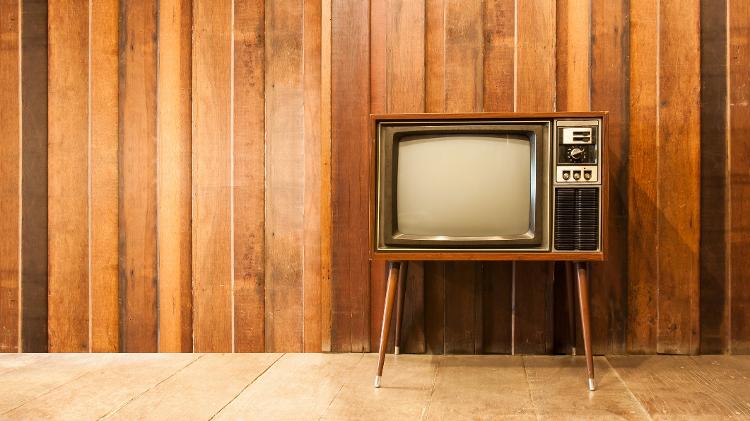—
Nunes collects video games and does not dispense with a period TV to have the most faithful experience possible
Image: Filipe Prates Nunes – Personal archive
–
“There were several factors that made me follow this path, such as nostalgia, the opportunity to buy a good TV at an interesting price and have space available for it in order to leave the consoles already connected, without having to install it every time I want to play”, he explains. “Besides, I think the picture the tube TV delivers is better.”
But if today’s TVs offer superior resolution and technology, what makes tube TVs better when it comes to plugging in an old set?
each in their own time
Most TVs today have small “lights” (LEDs) that light up individually to form images on the screen.
Tube TVs use a more complex process. The “tube” is a structure that resembles a funnel, with the largest area being the screen itself. At the bottom of it (the narrowest part), there are three cannons that release electrons when they receive a strong voltage electric. These electron beams follow in a straight line towards the screen and have their trajectory controlled by electromagnets.
In a color TV, each of the three beams is responsible for a basic color: red, green or blue (hence the color system is known as RGB: “red”, “green” and “blue”).
These threads sweep the screen at high speed and find another material on it: phosphor. Then, a reaction occurs that forms the colors and, consequently, each pixel of the image. The variation of tones has to do with different beams and the different intensities with which they fall on the same place.
The resolution of these screens is 640 by 480 pixels; while on 4K TVs that number jumps to 3,840 x 2,160 pixels. But older devices, like video games and VCRs, were created to take advantage of the standard resolution at the time.
They were also designed with the aspect ratio of the image displayed by these TVs in mind, 4:3, which is a little more “square”. The one on current TVs, 16:9, is a horizontal rectangle more similar to a movie screen.
This issue of incompatible proportions is easily circumvented in modern TVs, as they allow you to adjust the image with black bars on the sides, without having to stretch it to occupy the entire screen.
The biggest problem, however, is with the resolution. Modern TVs perform a process called upscaling, which consists of treating the received image in order to artificially increase its resolution.
It works well when a Full HD digital image (1920 by 1080 pixels) is displayed on a 4K screen. But when the image comes from an old device… the difference in resolution is huge. And the signal is generated analogically – current TVs only work with digital signal. The result of such extreme upascaling is a poor quality image, often blurry and lacking in definition.
Does this mean that you will always get a bad result if you plug one of these devices into a modern TV? Not really.
a little extra help
When TV upscaling doesn’t work, devices designed for this purpose come into play: scalers.
“They digitize the signal sent by a video game, for example, and increase that resolution to up to 1,920 x 1,080 pixels, making it more suitable for modern TVs. And they manage to do this treatment with little or no delay, especially those developed especially for games”, explains Michelin.
One of these devices, called GBS Control, is manufactured by Michelin itself and, in Brazil, is the best option in terms of cost-effectiveness.
Having a scaler on hand, however, is only part of the journey. It is also necessary to buy specific cables (which vary according to the type of output connector on the devices) and sometimes even make modifications. It’s a process that can be expensive, but tends to result in picture quality on par with a tube TV.
What if you want a tube TV anyway?
If the idea is to relive the past, there are some recommendations when looking for this type of device.
The first is to avoid buying televisions from less recognized or very cheap brands. Chances are good that you’ll end up taking home a faulty TV, which can become a huge problem. headache. Even because, nowadays, it is not so easy to find specialists in this type of repair.
“Old TVs were more susceptible to defects and were less reliable than the current ones”, says Eduardo PouzadaPhD and professor of Electrical Engineering at the IMT (Maua Institute of Technology).
“A critical point is the tube itself, a component that generates heat and requires high voltage power supply, about 26,000 volts. So the TV needs to be in an open environment for ventilation, but then there is the possibility of dust accumulation affecting the high voltage circuits. Even the mechanical fragility of the tube makes these devices subject to problems”, he explains.
So, if you are going to buy a used one, it is safer to bet on high-end brands of the time. And always test the product before closing the deal, to check if the image appears without blemishes or distortions. If it is in good condition, the installation in your house needs to be in an airy and resistant furniture (after all, they are heavy). And, if possible, leave the TV covered when not in use to prevent dust from accumulating.
–


